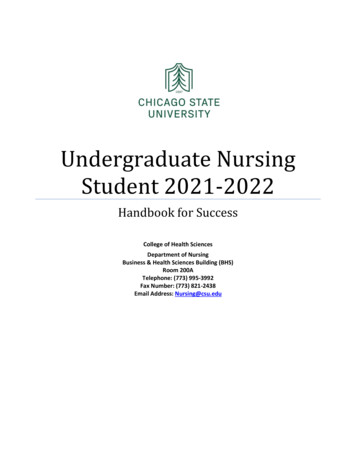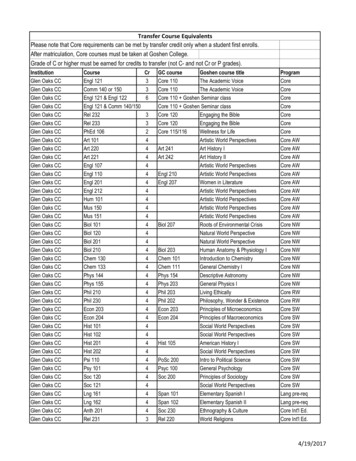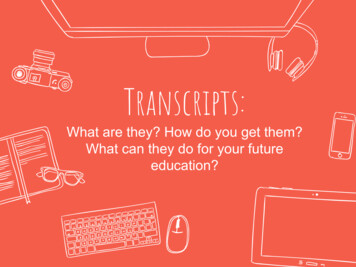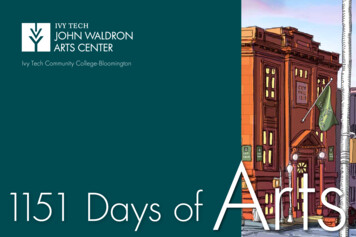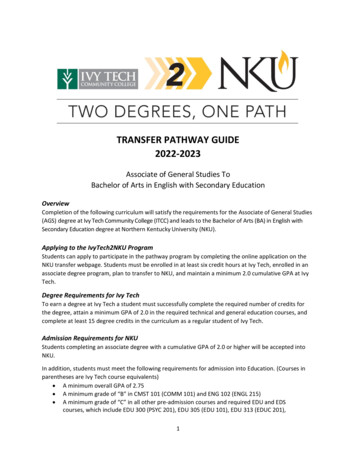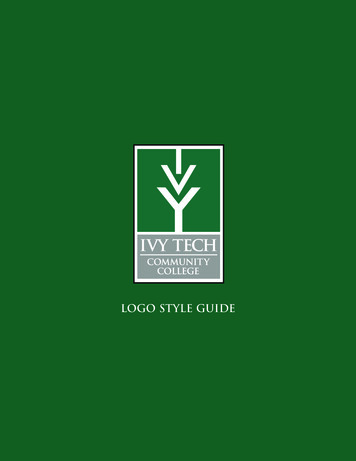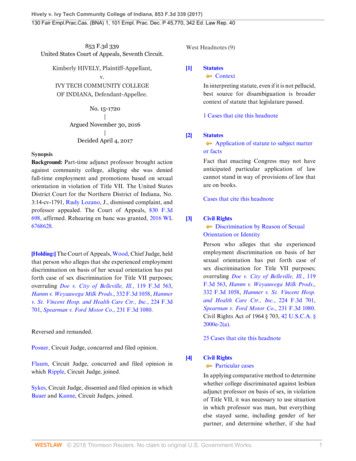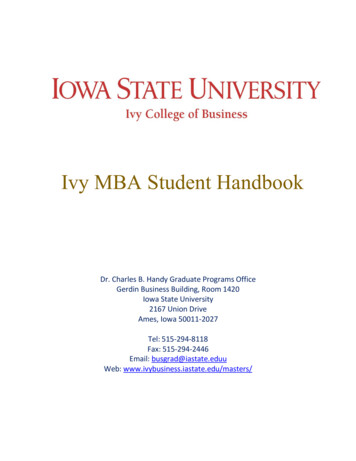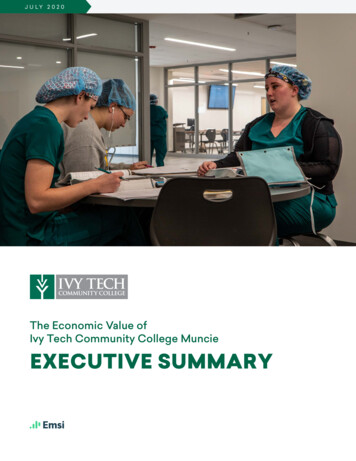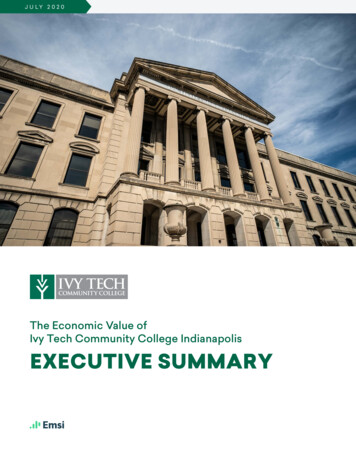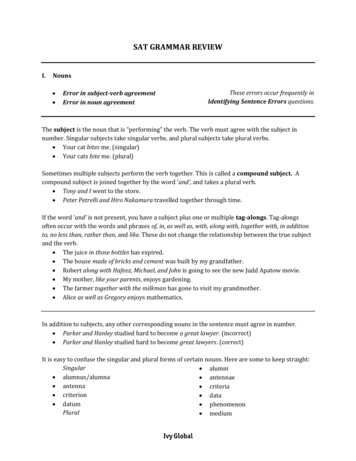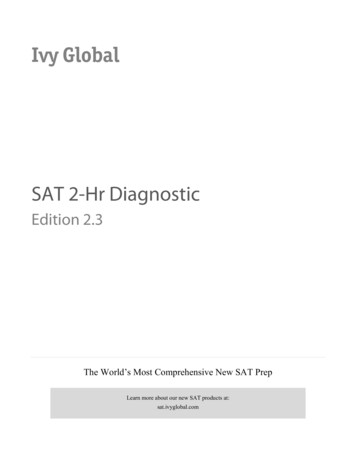
Transcription
Ivy GlobalSAT 2-Hr DiagnosticEdition 2.3The World’s Most Comprehensive New SAT PrepLearn more about our new SAT products at:sat.ivyglobal.com
About the PublisherThis diagnostic was written and edited by the team at Ivy Global, a pioneering education company that delivers a wide rangeof educational services.E-mail: publishing@ivyglobal.comWebsite: http://www.ivyglobal.comEdition 2.3 – Copyright 2020 by Ivy Global. All rights reserved.SAT is a registered trademark of the College Board, which is not affiliated with this publication.
YOUR NAME (PRINT):LASTFIRSTMISATThis exam is a short diagnostic to help you assess your general strengths and weaknesses for the new SAT.Directions Work on just one section at a time. If you complete a section before the end of your allotted time, use the extra minutes to check yourwork on that section only. Do NOT use the time to work on another section.Using Your Test Booklet No credit will be given for anything written in the test booklet. You may use the test booklet forscratch paper. You are not allowed to continue answering questions in a section after the allotted time has runout. This includes marking answers on your answer sheet that you previously noted in your testbooklet. You are not allowed to fold pages, take pages out of the test booklet, or take any pages home.Answering Questions Each answer must be marked in the corresponding row on the answer sheet. Each bubble must be filled in completely and darkly within the lines.CorrectIncorrect Be careful to bubble in the correct part of the answer sheet. Extra marks on your answer sheet may be marked as incorrect answers and lower your score. Make sure you use a No. 2 pencil.Scoring You will receive one point for each correct answer. Incorrect answers will NOT result in points deducted. Even if you are unsure about an answer, youshould make a guess.DO NOT BEGIN THIS TESTUNTIL YOUR PROCTOR TELLS YOU TO DO SO Ivy Global SAT 2-Hr DiagnosticThis exam is not licensed for commercial use.3
. Section 1ABCD1⃝ ⃝ ⃝ ⃝2⃝ ⃝ ⃝ ⃝3⃝ ⃝ ⃝ ⃝4⃝ ⃝ ⃝ ⃝5⃝ ⃝ ⃝ ⃝6⃝ ⃝ ⃝ ⃝AAAAABBBBBCCCCCABCD7⃝ ⃝ ⃝ ⃝8⃝ ⃝ ⃝ ⃝9⃝ ⃝ ⃝ ⃝10⃝ ⃝ ⃝ ⃝11⃝ ⃝ ⃝ ⃝12⃝ ⃝ ⃝ ⃝10⃝ ⃝ ⃝ ⃝11⃝ ⃝ ⃝ ⃝12⃝ ⃝ ⃝ ⃝13⃝ ⃝ ⃝ ⃝14⃝ ⃝ ⃝ ⃝15⃝ ⃝ ⃝ ⃝16⃝ ⃝ ⃝ ⃝17⃝ ⃝ ⃝ ⃝18⃝ ⃝ ⃝ ⃝DADADADADABBBBBCCCCCABCD13⃝ ⃝ ⃝ ⃝14⃝ ⃝ ⃝ ⃝15⃝ ⃝ ⃝ ⃝16⃝ ⃝ ⃝ ⃝17⃝ ⃝ ⃝ ⃝18⃝ ⃝ ⃝ ⃝19⃝ ⃝ ⃝ ⃝20⃝ ⃝ ⃝ ⃝21⃝ ⃝ ⃝ ⃝22⃝ ⃝ ⃝ ⃝23⃝ ⃝ ⃝ ⃝24⃝ ⃝ ⃝ ⃝25⃝ ⃝ ⃝ ⃝26⃝ ⃝ ⃝ ⃝27⃝ ⃝ ⃝ ⃝DADADADADABBBBBCCCCCABCD19⃝ ⃝ ⃝ ⃝20⃝ ⃝ ⃝ ⃝21⃝ ⃝ ⃝ ⃝22⃝ ⃝ ⃝ ⃝23⃝ ⃝ ⃝ ⃝24⃝ ⃝ ⃝ ⃝28⃝ ⃝ ⃝ ⃝29⃝ ⃝ ⃝ ⃝30⃝ ⃝ ⃝ ⃝31⃝ ⃝ ⃝ ⃝32⃝ ⃝ ⃝ ⃝33⃝ ⃝ ⃝ ⃝34⃝ ⃝ ⃝ ⃝35⃝ ⃝ ⃝ ⃝36⃝ ⃝ ⃝ DABCDABCDABCDABCDABCDABCDABCD25⃝ ⃝ ⃝ ⃝26⃝ ⃝ ⃝ ⃝27⃝ ⃝ ⃝ ⃝28⃝ ⃝ ⃝ ⃝29⃝ ⃝ ⃝ ⃝30⃝ ⃝ ⃝ ⃝37⃝ ⃝ ⃝ ⃝38⃝ ⃝ ⃝ ⃝39⃝ ⃝ ⃝ ⃝40⃝ ⃝ ⃝ ⃝41⃝ ⃝ ⃝ ⃝42⃝ ⃝ ⃝ ⃝43⃝ ⃝ ⃝ ⃝44⃝ ⃝ ⃝ ⃝DDDDD . Section 2ABCD1⃝ ⃝ ⃝ ⃝2⃝ ⃝ ⃝ ⃝3⃝ ⃝ ⃝ ⃝4⃝ ⃝ ⃝ ⃝5⃝ ⃝ ⃝ ⃝6⃝ ⃝ ⃝ ⃝7⃝ ⃝ ⃝ ⃝8⃝ ⃝ ⃝ ⃝9⃝ ⃝ ⃝ ⃝AAAAAAAA BBBBBBBBCCCCCCCCADADADADADADADADAIvy Global SAT 2-Hr DDDDDDDDDThis exam is not licensed for commercial use.5
. Section 312ABCDABCD567910/⃝ ⃝/⃝ ⃝/⃝ ⃝D.⃝ ⃝ ⃝ ⃝.⃝ ⃝ ⃝ ⃝.⃝ ⃝ ⃝ ⃝⃝ ⃝ ⃝ ⃝0⃝ ⃝ ⃝ ⃝0⃝ ⃝ ⃝ ⃝0⃝ ⃝ ⃝ ⃝1⃝ ⃝ ⃝ ⃝1⃝ ⃝ ⃝ ⃝1⃝ ⃝ ⃝ ⃝2⃝ ⃝ ⃝ ⃝2⃝ ⃝ ⃝ ⃝2⃝ ⃝ ⃝ ⃝3⃝ ⃝ ⃝ ⃝3⃝ ⃝ ⃝ ⃝3⃝ ⃝ ⃝ ⃝4⃝ ⃝ ⃝ ⃝4⃝ ⃝ ⃝ ⃝4⃝ ⃝ ⃝ ⃝5⃝ ⃝ ⃝ ⃝5⃝ ⃝ ⃝ ⃝5⃝ ⃝ ⃝ ⃝6⃝ ⃝ ⃝ ⃝6⃝ ⃝ ⃝ ⃝6⃝ ⃝ ⃝ ⃝7⃝ ⃝ ⃝ ⃝7⃝ ⃝ ⃝ ⃝7⃝ ⃝ ⃝ ⃝8⃝ ⃝ ⃝ ⃝8⃝ ⃝ ⃝ ⃝8⃝ ⃝ ⃝ ⃝9⃝ ⃝ ⃝ ⃝9⃝ ⃝ ⃝ ⃝9⃝ ⃝ ⃝ ⃝A48⃝ ⃝ ⃝ ⃝A3Only answers that are gridded will be scored. You will not receive credit for anything written in the boxes.⃝ ⃝ ⃝ ⃝BBCCD⃝ ⃝ ⃝ ⃝ABCDABCDABCD⃝ ⃝ ⃝ ⃝⃝ ⃝ ⃝ ⃝⃝ ⃝ ⃝ ⃝ . Section 4ABCD1⃝ ⃝ ⃝ ⃝2⃝ ⃝ ⃝ ⃝3⃝ ⃝ ⃝ ⃝4⃝ ⃝ ⃝ ⃝AAABBBCCCABCD5⃝ ⃝ ⃝ ⃝6⃝ ⃝ ⃝ ⃝7⃝ ⃝ ⃝ ⃝8⃝ ⃝ ⃝ ⃝DADADABBBCCCABCD9⃝ ⃝ ⃝ ⃝10⃝ ⃝ ⃝ ⃝11⃝ ⃝ ⃝ ⃝12⃝ ⃝ ⃝ ⃝DADADABBBCCCABCDABCDABCDABCD13⃝ ⃝ ⃝ ⃝14⃝ ⃝ ⃝ ⃝15⃝ ⃝ ⃝ ⃝16⃝ ⃝ ⃝ ⃝DDDOnly answers that are gridded will be scored. You will not receive credit for anything written in the boxes.176181920/⃝ ⃝/⃝ ⃝/⃝ ⃝/⃝ ⃝.⃝ ⃝ ⃝ ⃝.⃝ ⃝ ⃝ ⃝.⃝ ⃝ ⃝ ⃝.⃝ ⃝ ⃝ ⃝0⃝ ⃝ ⃝ ⃝0⃝ ⃝ ⃝ ⃝0⃝ ⃝ ⃝ ⃝0⃝ ⃝ ⃝ ⃝1⃝ ⃝ ⃝ ⃝1⃝ ⃝ ⃝ ⃝1⃝ ⃝ ⃝ ⃝1⃝ ⃝ ⃝ ⃝2⃝ ⃝ ⃝ ⃝2⃝ ⃝ ⃝ ⃝2⃝ ⃝ ⃝ ⃝2⃝ ⃝ ⃝ ⃝3⃝ ⃝ ⃝ ⃝3⃝ ⃝ ⃝ ⃝3⃝ ⃝ ⃝ ⃝3⃝ ⃝ ⃝ ⃝4⃝ ⃝ ⃝ ⃝4⃝ ⃝ ⃝ ⃝4⃝ ⃝ ⃝ ⃝4⃝ ⃝ ⃝ ⃝5⃝ ⃝ ⃝ ⃝5⃝ ⃝ ⃝ ⃝5⃝ ⃝ ⃝ ⃝5⃝ ⃝ ⃝ ⃝6⃝ ⃝ ⃝ ⃝6⃝ ⃝ ⃝ ⃝6⃝ ⃝ ⃝ ⃝6⃝ ⃝ ⃝ ⃝7⃝ ⃝ ⃝ ⃝7⃝ ⃝ ⃝ ⃝7⃝ ⃝ ⃝ ⃝7⃝ ⃝ ⃝ ⃝8⃝ ⃝ ⃝ ⃝8⃝ ⃝ ⃝ ⃝8⃝ ⃝ ⃝ ⃝8⃝ ⃝ ⃝ ⃝9⃝ ⃝ ⃝ ⃝9⃝ ⃝ ⃝ ⃝9⃝ ⃝ ⃝ ⃝9⃝ ⃝ ⃝ ⃝This exam is not licensed for commercial use. SAT 2-Hr Diagnostic Ivy Global
Section 1
11.Reading Test35 MINUTES, 30 QUESTIONSTurn to Section 1 of your answer sheet to answer the questions in this section.DIRECTIONSEvery passage or paired set of passages is accompanied by a number of questions. Read the passageor paired set of passages, then use what is said or implied in what you read and in any given graphicsto choose the best answer to each question.Questions 1-10 are based on the followingpassage.This passage is adapted from A. A. Milne, The Red HouseMystery. Originally published in 1922.Line510152025The “Temple” was a brick summer-house, in thegardens at the back of The Red House, about threehundred yards away. Here Mark, the house’s master,meditated sometimes before retiring to the “office” toput his thoughts upon paper. The thoughts were notof any great value; moreover, they were given off atthe dinner-table more often than they got on to paper,and got on to paper more often than they got intoprint. But that did not prevent the master of The RedHouse from being a little pained when a visitortreated the Temple carelessly, as if it had beenerected for the ordinary purposes of flirtation andsmoking. There had been an occasion when two ofhis guests had been found playing hand-tennis in it.Mark had said nothing at the time, save to ask with alittle less than his usual point—whether they couldn’tfind anywhere else for their game, but the offenderswere never asked to The Red House again.Audrey, the parlour-maid, walked slowly up tothe Temple, looked in, and walked slowly back. Theimmediate business was to find the master, but allthat walk was for nothing. Perhaps the master wasupstairs in his room, and—listen! One of the menshooting rabbits. Mrs. Stevens, Audrey’s aunt, waspartial to a nice rabbit, and onion sauce. How hot itwas, yet she wouldn’t say no to a cup of tea.303540455055She came into the house. As she passed thehousekeeper’s room on her way to the hall, the dooropened suddenly, and a rather frightened face lookedout.“Hallo, Aud,” said Elsie. She was one of thehousemaids. “It’s Audrey,” she said, turning into theroom.“Come in, Audrey,” called Mrs. Stevens.“What’s up?” said Audrey, looking in at the door.“Oh, my dear, you gave me such a turn. Wherehave you been?”“Up to the Temple.”“Did you hear anything?”“Hear what?”“Bangs and explosions and terrible things.”“Oh!” said Audrey, rather relieved. “One of themen shooting rabbits. Why, I said to myself as Icame along, ‘Auntie’s partial to a nice rabbit,’ I said,and I shouldn’t be surprised if—”“Rabbits!” said her aunt scornfully. “It was insidethe house, my girl.”“Straight it was,” said Elsie. “I said to Mrs.Stevens—didn’t I, Mrs. Stevens? —‘That was in thehouse,’ I said.”Audrey looked at her aunt and then at Elsie.“Do you think he had a revolver with him?” shesaid in a hushed voice.“Who?” said Elsie excitedly.“That brother of Mark’s. From Australia. I said assoon as I set eyes on him, ‘You’re a bad lot, my man!’CONTINUE Ivy Global SAT 2-Hr DiagnosticThis exam is not licensed for commercial use.9
160657075That’s what I said, Elsie. Even before he spoke tome. Rude!” She turned to her aunt. “Well, I give youmy word.”“If you remember, Audrey, I always said therewas no use speaking with anyone from Australia.”Mrs. Stevens lay back in her chair, breathing ratherrapidly. “I wouldn’t go out of this room now, not ifyou paid me a hundred thousand pounds.”“Oh, Mrs. Stevens!” said Elsie, who badly wantedfive shillings for a new pair of shoes, “I wouldn’t goas far as that, not myself, but—”“There!” cried Mrs. Stevens, sitting up with astart. They listened anxiously, the two girlsinstinctively coming closer to the older woman’schair.A door was being shaken, kicked, rattled.“Listen!”Audrey and Elsie looked at each other withfrightened eyes.113As used in line 4, “retiring” most nearly meansA) deteriorating.B) retreating.C) discharging.D) surrendering.4As used in line 12, “ordinary” most nearly meansA) natural.B) boring.C) distasteful.D) unremarkable.5What can be reasonably inferred when Mark does notask certain guests back to The Red House in lines 1518 is that the “Temple” isWhich choice best summarizes the passage?A) The master of a house is sought, and his maidshear a startling sound.A) off-limits to guests and visitors.B) Housemaids discuss their employer, and witnessan exciting rabbit hunt.B) embarrassingly run-down and outdated.C) A temple is described, and its master harshlycriticizes his housemaids.D) viewed by Mark as a place for quiet.D) A gunshot is heard, and housemaids hide in abedroom from their employer.C) home to Mark’s wayward older brother.6Which choice provides the best evidence for theanswer to the previous question?2The passage is narrated byA) a frightened bystander.B) a meticulous analyst.C) an omniscient observer.A) Lines 1-3 (“The Temple away”)B) Lines 9-13 (“But that smoking”)C) Lines 13-14 (“There had it”)D) Lines 20-22 (“The immediate nothing”)D) a bored houseguest.CONTINUE10This exam is not licensed for commercial use. SAT 2-Hr Diagnostic Ivy Global
171.9The rhetorical effect of Mrs. Stevens’s description ofthe gunshots in line 41 is toWhich choice provides the best evidence for theanswer to the previous question?A) allude to Mrs. Stevens’s extensive knowledge ofguns.A) Lines 27-30 (“As she looked out”)B) Lines 42-43 (“One of rabbits”)B) elicit feelings of disgust toward the sport ofhunting.C) foreshadow Mrs. Stevens’s participation in acrime.D) signal a potential and previously unrecognizeddanger.8The narrator indicates that Audrey and Mrs. Stevensbelieve Mark’s brother to beA) impolite and noticeably suspicious.B) wealthy and slightly arrogant.C) charming and consistently hospitable.D) imposing and exhaustingly overbearing.C) Lines 55-56 (“I said man”)D) Lines 63-64 (“I wouldn’t pounds”)10The author most likely includes Elsie’s desire for anew pair of shoes in lines 65-66 toA) suggest that Elsie is not focused on the currentsituation.B) reveal that the housemaids do not have properfootwear.C) emphasize Elsie’s initiative in dangerousenvironments.D) show that Elsie is only concerned about herphysical appearance.CONTINUE Ivy Global SAT 2-Hr DiagnosticThis exam is not licensed for commercial use.11
1Questions 11-21 are based on the followingpassage and supplementary material.1In the early 1970s, Dr. Grubb Jr. showed that40 tube-nosed seabirds use their powerful sense of smellThis passage is adapted from Matthew Savoca, “Theoceans are full of plastic, but why do seabirds eat it?” 2016 by Matthew Savoca.Line5101520253035Plastic debris can be found in oceans around theworld. Scientists have estimated that there areover five trillion pieces of plastic, weighing morethan a quarter of a million tons, floating at seaglobally. Plastic does not biodegrade, but at sea largepieces of plastic break down into increasinglysmaller fragments that are easy for animals toconsume. Animals that mistake plastic for a mealmay suffer from malnutrition, intestinal blockage, orslow poisoning from chemicals in or attached to theplastic.Despite the pervasiveness and severity of thisproblem, scientists still do not fully understand whyso many marine animals make this mistake. It hasbeen commonly assumed, but rarely tested, thatseabirds eat plastic debris because it looks like theirnatural prey. However, we propose a new explanation:for many imperiled species, marine plastic debrisalso produces an odor that the birds associate withfood.Perhaps the most severely impacted animalsare tube-nosed seabirds, a group that includesalbatrosses, shearwaters, and petrels. Many are atrisk of extinction; according to the InternationalUnion for the Conservation of Nature, nearly half ofthe approximately 120 species of tube-nosedseabirds are either threatened, endangered, orcritically endangered. As well, these birds arepelagic: they often remain at sea for years at a time,searching for food over hundreds or thousands ofsquare kilometers of open ocean. Although there aremany fish in the sea, areas that reliably contain foodare very patchy—tube-nosed seabirds are searchingfor a needle in a haystack when they forage. Theymay be searching for fish, squid, krill, or other items,and it is possible that plastic debris visuallyresembles these prey. But we believe that tells onlypart of a more complex story.4550556065707580to find food effectively. Later, Dr. Nevitt andcolleagues found that certain species of tube-nosedseabirds are attracted to dimethyl sulfide (DMS), anaturally scented sulfur compound. DMS comesfrom marine algae, which produce a related chemicalcalled DMSP inside their cells. When those cells aredamaged—for example, when algae die, or whenmarine grazers like krill eat it—DMSP breaks down,producing DMS. The smell of DMS alerts seabirdsthat food is nearby—not the algae, but the krill thatare consuming the algae.Dr. Nevitt and I wondered whether these seabirdswere being tricked into consuming marine plasticdebris because of the way it smelled. To test thisidea, my co-authors and I created a databasecollecting every study we could find that recordedplastic ingestion by tube-nosed seabirds over the past50 years. This research showed that species of birdsthat use DMS as a foraging cue eat plastic nearly sixtimes as frequently as species that are not attracted tothe smell of DMS while foraging.To further test our theory, we needed to analyzehow marine plastic debris smells. To do so, I tookbeads of the three most common types of floatingplastic—polypropylene and low- and high-densitypolyethylene—and sewed them inside custom meshbags, which we attached to two buoys off ofCalifornia’s central coast. We hypothesized thatalgae would coat the plastic at sea, a process knownas biofouling, and produce DMS.After the plastic had been immersed for about amonth at sea, we retrieved it and brought it to a lab.There we used a gas chromatograph, specificallybuilt to detect sulfur odors, to measure the chemicalsignature of our experimental marine debris. Sulfurcompounds have a very distinct odor; to humans theysmell like rotten eggs or decaying seaweed on thebeach, but to some species of seabirds DMS smellsdelicious!As proposed, every sample of plastic we collectedwas coated with algae and had substantial amounts ofCONTINUE12This exam is not licensed for commercial use. SAT 2-Hr Diagnostic Ivy Global
11DMS associated with it. We found levels of DMSthat were higher than normal backgroundconcentrations in the environment, and well above85 levels that tube-nosed seabirds can detect and use tofind food. Our results provide the first evidence that,in addition to looking like food, plastic debris mayalso confuse seabirds that hunt by smell.12Which of the following situations is most analogousto the problem presented in the passage?A) A young boy ingests harmful pills that resemblecandy.B) A man makes changes to his diet to improve hishealth.Plastic ingestion and DMSresponsiveness in seabirdsC) A woman eats strawberries despite knowing sheis allergic to them.100%Percentage of seabirdsingesting plastic.D) A tourist is afraid to try a traditionally spicylocal cuisine.75%50%1325%The passage most clearly implies thatA) plastic smells like DMS because of its artificialnature.0%B) seabird prey ingest plastic in order to produceDMS.C) the biofouling process leads to production ofDMS.D) all plastic smells like DMS until it is properlycleaned.Seabird speciesNon-DMS-responsive speciesDMS-responsive species14Which choice best supports the answer to theprevious question?A) Lines 5-8 (“Plastic does consume”)11The central claim of the passage is thatB) Lines 34-37 (“They may prey”)A) DMS is a harmful chemical that should beremoved from our oceans.D) Lines 80-82 (“As proposed it”)C) Lines 49-51 (“The smell algae”)B) Species that ingest plastic are in danger ofbecoming extinct.C) The smell of plastic leads some seabird speciesto mistake it for food.D) The production of DMS is crucial to the study ofmarine life.CONTINUE Ivy Global SAT 2-Hr DiagnosticThis exam is not licensed for commercial use.13
1151.19The author mentions that tube-nosed seabirds are atrisk of extinction primarily toAs used in line 59, “cue” most nearly meansA) share his strong concern for all endangeredspecies.B) signal.A) nod.C) warning.B) imply that animals usually go extinct because ofa lack of food.C) show that seabirds are uniquely vulnerable toingesting plastic waste.D) suggestion.20D) emphasize the seriousness of seabirds ingestingplastic.Which choice is best supported by the graph?A) Seabird species all ingest roughly the sameamount of plastic.16B) Seabirds eventually learn to differentiate plasticfrom food.The author makes use of which of the following tosupport his argument?C) Seabirds become more responsive to DMS themore they encounter it.A) Results from research he conductedB) Interviews with marine biologistsD) Seabird species that do not detect DMS consumeless plastic.C) Reports on where seabirds usually find their foodD) Studies on the chemical composition of DMS2117Which choice provides the best evidence for theanswer to the previous question?A) Lines 14-17 (“It has prey”)B) Lines 39-41 (“In the effectively”)C) Lines 71-72 (“After the plastic lab”)D) Lines 86-88 (“Our results smell”)Based on the passage and graph, which of thefollowing is true of DMS?A) DMS is the only reason some seabird speciesmistakenly ingest plastic.B) Certain DMS-responsive seabird species arebetter at detecting DMS than others.C) Attraction to DMS makes seabirds significantlymore likely to ingest plastic.D) DMS is only detectable by seabirds within acertain range of its source.18As used in line 34, “forage” most nearly meansA) chase.B) hunt.C) explore.D) ransack.CONTINUE14This exam is not licensed for commercial use. SAT 2-Hr Diagnostic Ivy Global
11Questions 22-30 are based on the followingpassage.This passage is adapted from Shirley Chisolm, “For theEqual Rights Amendment,” delivered before the UnitedStates Congress in 1970. Chisolm, the first AfricanAmerican woman elected to Congress, was arguing infavor of a Constitutional amendment securing legalequality between men and women.Line5101520253035The resolution before us today, which providesfor equality under the law for both men and women,represents one of the most clear-cut opportunities weare likely to have to declare our faith in the principlesthat shaped our Constitution. It provides a legal basisfor attack on the most subtle, most pervasive, andmost institutionalized form of prejudice that exists.Discrimination against women, solely on the basis oftheir sex, is so widespread that is seems to manypersons normal, natural, and right.Legal expression of prejudice on the grounds ofreligious or political belief has become a minorproblem in our society. Prejudice on the basis of raceis, at least, under systematic attack. It is time we actto assure full equality of opportunity to those citizenswho, although in a majority, suffer the restrictionsthat are commonly imposed on minorities—women.The argument that this amendment will not solvethe problem of sex discrimination is not relevant. Ifthe argument were used against a civil rights bill, asit has been used in the past, the prejudice that liesbehind it would be embarrassing. Of course laws willnot eliminate prejudice from the hearts of humanbeings. But that is no reason to allow prejudice tocontinue to be enshrined in our laws—to perpetuateinjustice through inaction.What would the legal effects of the equal rightsamendment really be? The equal rights amendmentwould govern only the relationship between the Stateand its citizens—not relationships between privatecitizens. The amendment would be largely selfexecuting, that is, any Federal or State laws inconflict would be ineffective one year after the dateof ratification without further action by the Congressor State legislatures.Jury service laws not making women equallyliable for jury service would have been revised. The404550556065707580.selective service law would have to include women,but women would not be required to serve in theArmed Forces where they are not fitted any morethan men are required to serve.Survivorship benefits would be available tohusbands of female workers on the same basis as towives of male workers. Public schools anduniversities could not be limited to one sex and couldnot apply different admission standards to men andwomen. Laws requiring longer prison sentences forwomen than men would be invalid, and equalopportunities for rehabilitation and vocationaltraining would have to be provided in publiccorrectional institutions.What would be the economic effects of the equalrights amendment? Direct economic effects would beminor. If any labor laws applying only to women stillremained, their amendment or repeal would provideopportunity for women in better-paying jobs inmanufacturing. More opportunities in publicvocational and graduate schools for women wouldalso tend to open up opportunities in better jobs forwomen.Indirect effects could be much greater. Thefocusing of public attention on the gross legal,economic, and social discrimination against womenby hearings and debates in the Federal and Statelegislatures would result in changes in attitude ofparents, educators, and employers that would bringabout substantial economic changes in the long run.This is what it comes down to: artificialdistinctions between persons must be wiped out ofthe law. Legal discrimination between the sexes is, inalmost every instance, founded on outmoded viewsof society and the pre-scientific beliefs aboutpsychology and physiology. It is time to sweep awaythese relics of the past and set further generationsfree of them.The Constitution was designed to protect therights of white, male citizens. As there were no blackFounding Fathers, there were no founding mothers—a great pity, on both counts. It is not too late tocomplete the work they left undone. Today, here, weshould start to do so.CONTINUE Ivy Global SAT 2-Hr DiagnosticThis exam is not licensed for commercial use.15
1221.26The stance Chisolm takes in the passage is bestdescribed as that ofAs used in line 11, “expression” most nearly meansA) a weary radical.B) intensity.B) a passionate advocate.C) announcement.C) an excited politician.D) emotion.A) assertion.D) an optimistic scholar.2723Chisolm recognizes and dismisses which of thefollowing counterarguments?According to Chisolm, legal distinctions between thesexesA) Legal remedies are insufficient for eradicatingbias.A) protect important differences.B) are usually valid, but occasionally harmful.B) The Constitutional amendment would change thedemographics of the Armed Forces.C) reflect outdated thinking.C) America is already more equitable than othercountries.D) have only minimal effects.D) The Constitutional amendment would robwomen of certain benefits.24Which choice provides the best evidence for theanswer to the previous question?A) Lines 8-10 (“Discrimination against right”)28B) Lines 14-17 (“It is women”)Which choice provides the best evidence for theanswer to the previous question?C) Lines 27-28 (“What would be”)A) Lines 5-7 (“It provides exists”)D) Lines 70-73 (“Legal and physiology”)B) Lines 22-24 (“Of course beings”)C) Lines 28-30 (“The equal its citizens”)25D) Lines 53-54 (“Direct economic minor”)Chisolm characterizes discrimination against womenasA) unfortunate but unavoidable.B) accepted but unjust.C) embarrassing but necessary.D) illegal but common.CONTINUE16This exam is not licensed for commercial use. SAT 2-Hr Diagnostic Ivy Global
1291.30As used in line 40, “fitted” most nearly meansThe contrast between direct and indirect effects inlines 52-67 serves primarily toA) contoured.A) argue that although no one knows what theimmediate ramifications of the amendment willbe, the ultimate effect will be small.B) shaped.C) fixed.D) suited.B) imply that while some of the things people fearmay come to pass, there will also beunpredictable benefits.C) suggest that the impact of the amendment will beconsiderably larger in the future than in thepresent day.D) state that certain aspects of people’s lives will bechanged severely, while other aspects willremain much the same.STOPIf you complete this section before the end of your allotted time, check your work on thissection only. Do NOT use the time to work on another section. Ivy Global SAT 2-Hr DiagnosticThis exam is not licensed for commercial use.17
Section 2
22.Writing and Language Test35 MINUTES, 44 QUESTIONSTurn to Section 2 of your answer sheet to answer the questions in this section.DIRECTIONSEvery passage comes with a set of questions. Some questions will ask you to consider how the writermight revise the passage to improve the expression of ideas. Other questions will ask you to considercorrecting potential errors in sentence structure, usage, or punctuation. There may be one or moregraphics that you will need to consult as you revise and edit the passage.Some questions will refer to a portion of the passage that has been underlined. Other questions willrefer to a particular location in a passage or ask that you consider the passage in full.After you read the passage, select the answers to questions that most effectively improve thepassage's writing quality or that adjust the passage to follow the conventions of standard writtenEnglish. Many questions give you the option to select "NO CHANGE." Select that option in cases whereyou think the relevant part of the passage should remain as it currently is.Questions 1-11 are based on the following passage.Disputes in Ancient Greek PhilosophyPeople often speak of “the philosophy of the ancientGreeks” or “what the Greeks believed,” as though they1A) NO CHANGEB) Meanwhile, ancientC) AncientD) Consequently, ancienthad a single shared opinion. 1 . However, ancient Greekphilosophers held a great diversity of opinions, foundingmany schools of thought that shaped the development ofculture in the West and beyond.CONTINUE Ivy Global SAT 2-Hr DiagnosticThis exam is not licensed for commercial use.21
22 . The thinker Epicurus developed Epicureanism2.2in the 4th century BCE. Epicurus and his followersWhich choice most effectively conveys the maintopic of this paragraph?challenged 3 . humdrum beliefs of the time by claimingthat all events unfolded according to physical rules,A) One of the foremost of these philosophicalmovements was Epicureanism.without any intervention from the gods—but withB) Of course, thinkers in other parts of the worldalso developed many great philosophies.occasional random swerves of atoms. This stance washighly controversial in Greece’s polytheistic society.C) These schools often argued with one another,each claiming to have the best doctrine.Epicurus also stated that people could achieve happinessby avoiding suffering and enjoying natural pleasures,D) Many of these philosophers held positions thatGreek society considered unpopular andcontroversial.which led many to perceive him as endorsing selfindulgence. As a result, the word “epicurean” is used tothis day to describe someone who enjoys luxury anddecadence, especially in the realm of fine dining.3The most famous rivals of the Epicureans were theA) NO CHANGEStoics. The Stoic school of thought was founded in theB) routine4th century BCE by the 4 . philosopher Zeno. However,C) mundaneits most well-known follower, the Roman emperorD) conventionalMarcus Aurelius, lived and wrote much later, in the 2ndcentury CE. The Stoics, unlike the Epicureans, believedthat a 5 . divine will they called “the Logos” influenced4A) NO CHANGEall events. Thus, the Stoics thought that people could notB) philosopher Zeno, however, its mostcontrol their fates and so should cultivate self-control andC) philosopher Zeno but its mostcomposure, even in the face of hardship. Because of theseD) philosopher Zeno. Though its mostteachings, the word “stoic” has now come to mean“calm,” “steady,” or even “emotionless.”5A) NO CHANGEB) divine will, they calledC) divine will: they calledD) divine will—they calledCONTINUE22This exam is not licensed for commercial use. SAT 2-Hr Diagnostic Ivy Global
2[1] The Cynics, another group of philosophers with26roots in 4th century BCE Greece, held views similar toA) NO CHANGE6 . the Stoics. [2] For instance, the best-known Cynic,B) those Stoics.Diogenes of Sinope, lived in a large jar in the marketplaceC) Stoics.of Athens, begged and scavenged for food, and mockedD) those of the Stoics.7 . well-respected public figures who were held in highesteem. [3] They emphasized independence, however,claiming that desires for wealth and social power clouded7A) NO CHANGEthe mind. [4] Only if one gave up the pursuit of theseB) well-respected public figures of high esteemdesires, they said, could 8 . you live a virtuous life. [5]C) esteemed public figuresThe Cynics thus chose to live without possessions orD) respected public figures of esteemstatus and rejected social norms. [6] The Cynics’ distrustof societal institutions and authority has led to the word“cynical” being used to describe people who doubt the.8A) NO CHANGEmotivations of others and criticize society. 9 .B) one liveC) they liveD) he or she live9For the sake of the cohesion of this paragraph,sentence 2 should be placedA) where it is now.B) after sentence 3.C) after sentence 4.D) after sentence 5.CONTINUE Ivy Global SAT 2-Hr DiagnosticThis exam is not licensed for commercial use.23
2Greek philosophy has had a profound influence on210culture worldwide. Alexander the Great’s conquestA) NO CHANGEcarried these i
Ivy Global . SAT 2-Hr Diagnostic . Edition 2.3 . The World's Most Comprehensive New SAT Prep . Learn more about our new SAT products at: sat.ivyglobal.com . About the Publisher . This diagnostic was written and edited by the team at Ivy Global, a pioneering education company that delivers a wide range
